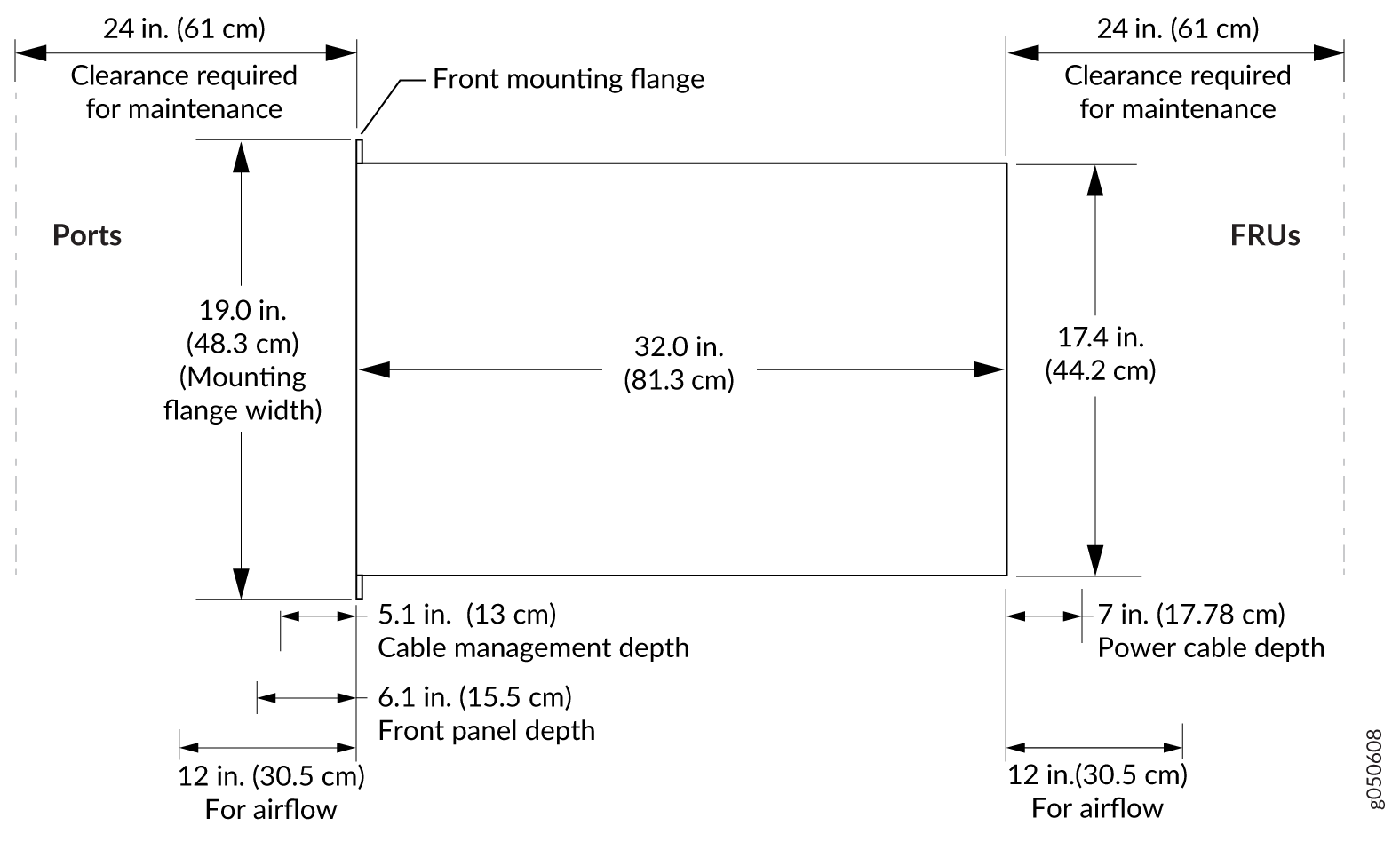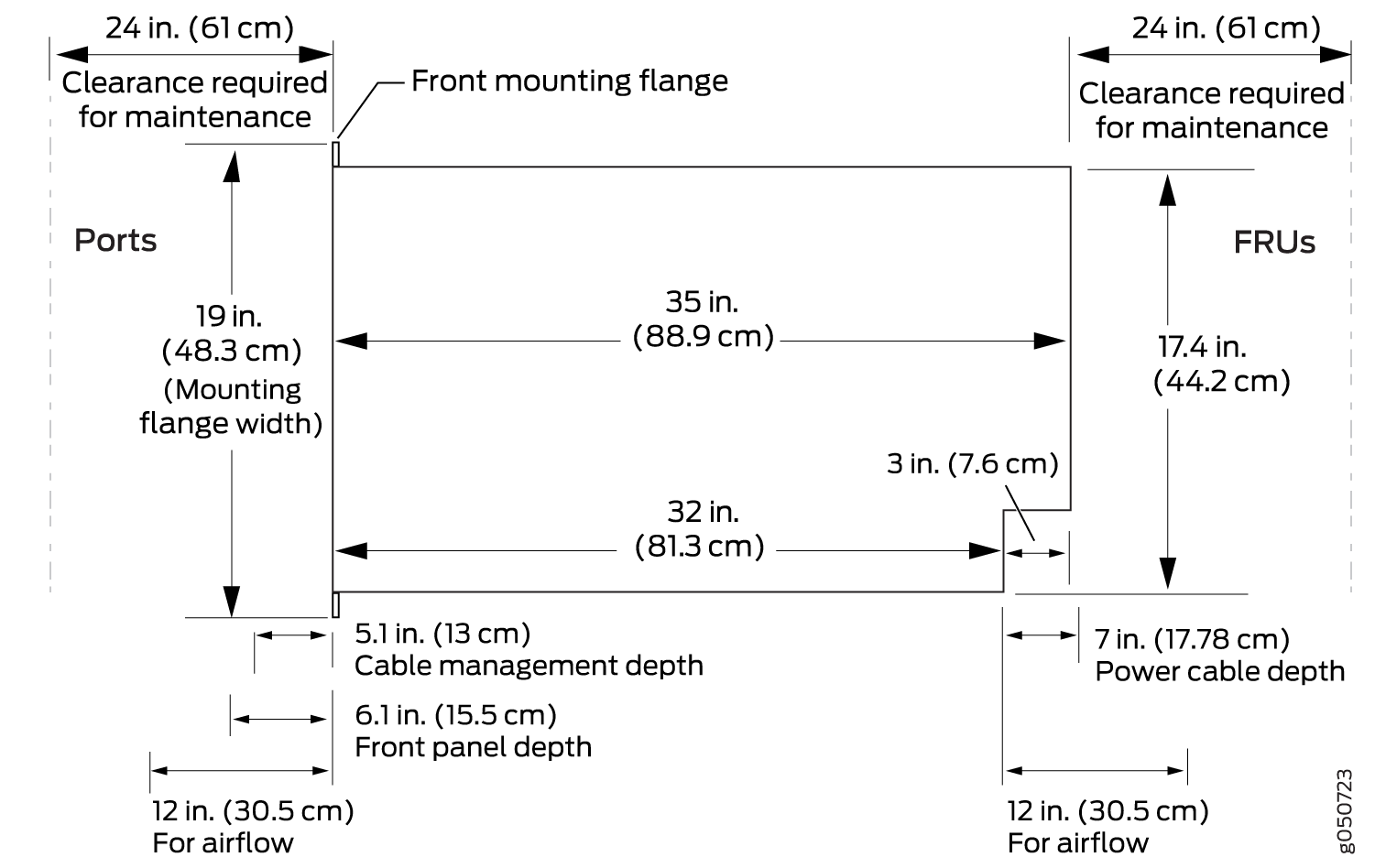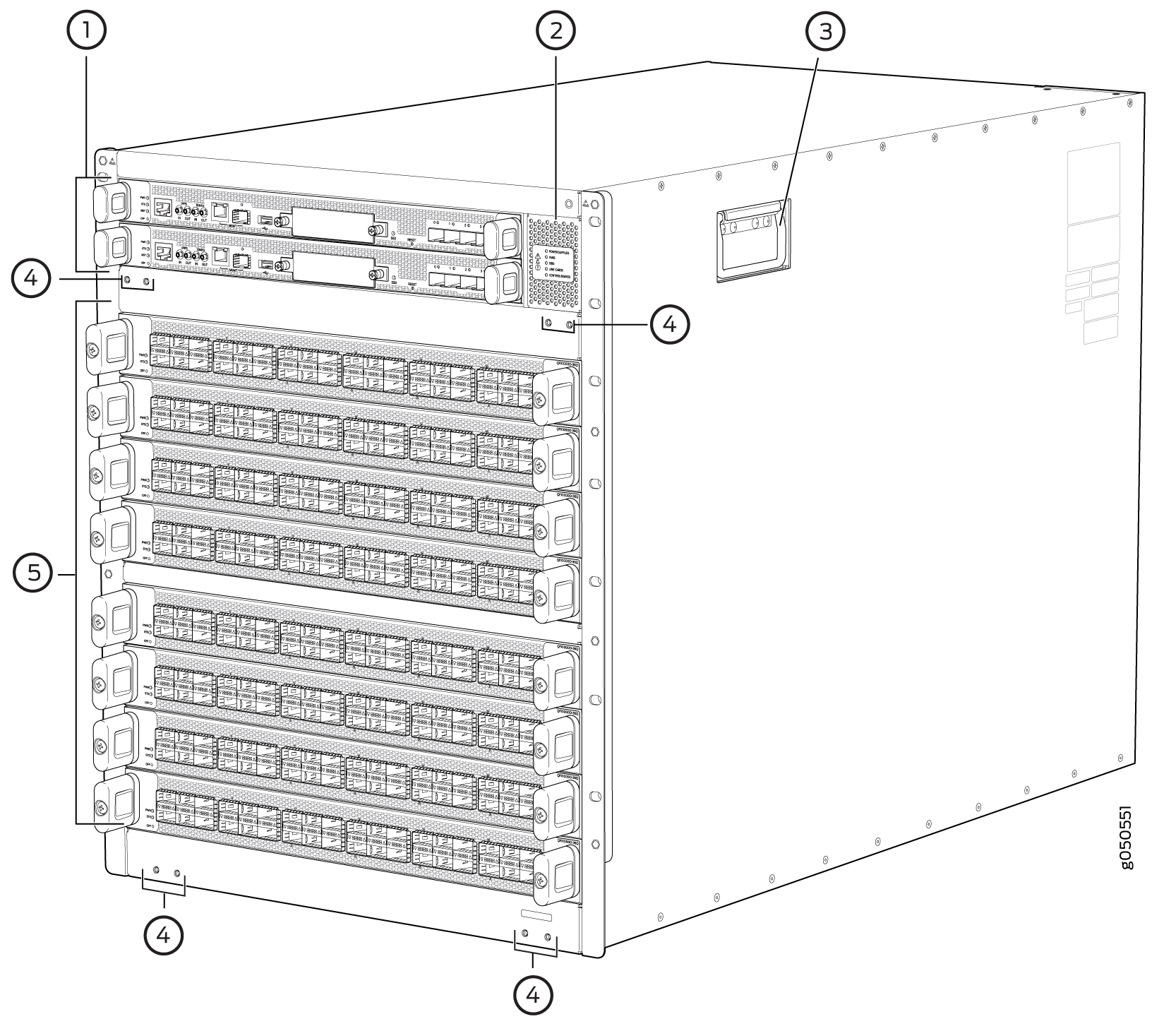QFX10008 Site Guidelines and Requirements
QFX10000 Environmental Requirements and Specifications
The QFX10008 and QFX10016 modular switches must be installed in a four-post rack. It must be housed in a dry, clean, well-ventilated, and temperature-controlled environment.
Follow these environmental guidelines:
The site must be as dust-free as possible, because dust can clog air intake vents and filters, reducing the efficiency of the switch cooling system.
Maintain ambient airflow for normal switch operation. If the airflow is blocked or restricted, or if the intake air is too warm, the switch might overheat, leading to the switch temperature monitor shutting down the device to protect the hardware components.
Table 1 provides the required environmental conditions for normal switch operation.
Description |
Tolerance |
|---|---|
Altitude |
No performance degradation to 6562 feet (2000 meters). |
Relative humidity |
Normal operation ensured in relative humidity range of 5% through 90%, noncondensing.
|
Temperature |
|
Seismic |
Designed to comply with Zone 4 earthquake requirements per NEBS GR-63-CORE, Issue 3. |
Install QFX10008 and QFX10016 modular switches only in restricted areas, such as dedicated equipment rooms and equipment closets, in accordance with Articles 110-16, 110-17, and 110-18 of the National Electrical Code, ANSI/NFPA 70.
See Also
General Site Guidelines
Efficient device operation requires proper site planning. For the device to operate properly, you must ensure maintenance and proper layout of the equipment, rack or cabinet, and wiring closet.
To plan and create an acceptable operating environment for your device and prevent environmentally caused equipment failures:
Keep the area around the chassis free from dust and conductive material, such as metal flakes.
Follow the prescribed airflow guidelines to ensure that the cooling system functions properly. Ensure that the exhaust from other equipment does not blow into the intake vents of the device.
Follow the prescribed electrostatic discharge (ESD) prevention procedures to prevent damaging the equipment. Static discharge can cause components to fail completely or intermittently over time.
Install the device in a secure area, so that only authorized personnel can access the device.
Site Electrical Wiring Guidelines
Table 2 describes the factors you must consider while planning the electrical wiring at your site.
You must provide a properly grounded and shielded environment and use electrical surge-suppression devices.
Avertissement Vous devez établir un environnement protégé et convenablement mis à la terre et utiliser des dispositifs de parasurtension.
|
Site Wiring Factor |
Guidelines |
|---|---|
|
Signaling limitations |
If your site experiences any of the following problems, consult experts in electrical surge suppression and shielding:
|
|
Radio frequency interference |
To reduce or eliminate RFI from your site wiring, do the following:
|
|
Electromagnetic compatibility |
If your site is susceptible to problems with electromagnetic compatibility (EMC), particularly from lightning or radio transmitters, seek expert advice. Strong sources of electromagnetic interference (EMI) can cause:
|
QFX10000 Rack Requirements
The QFX10000 modular switch chassis are designed to be installed in four-post racks.
Rack requirements consist of:
Rack type
Rack mount kit hole spacing
Rack size and strength
Rack connection to the building structure
Table 3 provides the rack requirements and specifications for the QFX10008 and the QFX10016.
Rack Requirement |
Guidelines |
|---|---|
Rack type: four-post |
Use a four-post rack that provides bracket holes or hole patterns spaced at 1 U (1.75 in. or 4.45 cm) increments and that meets the size and strength requirements to support the weight. A U is the standard rack unit defined in Cabinets, Racks, Panels, and Associated Equipment (document number EIA-310–D) published by the Electronics Industry Association. You can stack two QFX10016 or three QFX10008 chassis in a four-post rack if:
|
Rack mount kit hole spacing |
The holes in the rack mount kit are spaced at 1 U (1.75 in. or 4.45 cm), so that the switch can be mounted in any rack that provides holes spaced at that distance. |
Rack size and strength |
|
Rack connection to building structure |
|
See Also
QFX10000 Clearance Requirements for Airflow and Hardware Maintenance
When planning the site for a QFX10008 or QFX10016 installation, you must allow sufficient clearance around the installed chassis for cooling and maintenance (see Figure 1 for QFX10008 and Figure 2 for QFX100016).


Follow these guidelines:
For the cooling system to function properly, the airflow around the chassis must be unrestricted.
If you are mounting a QFX10000 in a rack with other equipment, ensure that the exhaust from other equipment does not blow into the intake vents of the chassis.
Leave at least 24 in. (61 cm) both in front of and behind the QFX10000 for service personnel to remove and install hardware components. To be NEBS GR-63 compliant, allow at least 30 in. (76.2 cm) in front of the rack and 24 in. (61 cm) behind the rack.
See Also
QFX10008 Chassis Physical Specifications
The QFX10008 modular chassis is a rigid sheet-metal structure that houses the other switch components. You can mount up to three QFX10008 chassis in a standard 19-in. 4-post rack (42 U) rack provided the rack can handle the combined weight and there is adequate power and cooling. Table 4 summarizes the physical specifications of the chassis. See Figure 3.
Description |
Weight |
Height |
Width |
Depth |
|---|---|---|---|---|
Chassis, spare |
145.2 lb (65.86 kg) |
22.6 in. (57.4 cm) |
17.4 in. (44.2 cm) Note:
The outer edges of the mounting-bracket flange extend the width to 19 in. (48.3 cm). |
32 in. (81.28 cm) |
Chassis base AC configuration Includes 1 RCB, 3 QFX10000-PWR-AC power supplies, 2 QFX10008-FAN fan trays, 2 QFX10008-FAN-CTRL fan tray controllers, and 5 Switch Interface Boards (SIBs) |
280 lb (127 kg) |
22.6 in. (57.4 cm) |
17.4 in. (44.2 cm) Note:
The outer edges of the mounting-bracket flange extend the width to 19 in. (48.3 cm). |
32 in. (81.28 cm) |
Chassis redundant AC configuration Includes 2 RCBs, 6 QFX10000-PWR-AC power supplies, QFX10008-FAN fan trays, 2 QFX10008-FAN-CTRL fan tray controllers, and 6 SIBs |
322 lb (146.06 kg) |
22.6 in. (57.4 cm) |
17.4 in. (44.2 cm) Note:
The outer edges of the mounting-bracket flange extend the width to 19 in. (48.3 cm). |
32 in. (81.28 cm) |
Chassis redundant DC configuration Includes 2 RCBs, 6 QFX10000-PWR-DC power supplies, QFX10008-FAN fan trays, 2 QFX10008-FAN-CTRL fan tray controllers, and 6 SIBs |
319 lb (144.7 kg) |
22.6 in. (57.4 cm) |
17.4 in. (44.2 cm) Note:
The outer edges of the mounting-bracket flange extend the width to 19 in. (48.3 cm). |
32 in. (81.28 cm) |
QFX10000-30C Line Card |
27 lb (12.2 kg) |
1.89 in. (4.8 cm) |
17.2 in. (43.7 cm) |
20.54 in. (52.2 c m) |
QFX10000-30C-M Line Card |
28.5 lb (12.9 kg) |
1.89 in. (4.8 cm) |
17.2 in. (43.7 cm) |
20.54 in. (52.2 cm) |
QFX10000-36Q Line Card |
22.6 lb (10.2 kg) |
1.89 in. (4.8 cm) |
17.2 in. (43.7 cm) |
20.54 in. (52.2 cm) |
QFX10000-60S-6Q Line Card |
21.4 lb (9.7 kg) |
1.89 in. (4.8 cm) |
17.2 in. (43.7 cm) |
20.54 in. (52.2 cm) |
QFX10K-12C-DWDM |
31 lb (14.06 kg) |
1.89 in. (4.8 cm) |
17.2 in. (43.7 cm) |
20.54 in. (52.2 cm) |

1 — Control boards | 4 — Mounting holes for front panel |
2 — Status panel | 5 — Line cards |
3 — Handles |
The handles on each side of the chassis facilitate the fine-tune positioning of the chassis on the mounting brackets. Do not use the handles to lift the chassis, even when the chassis is empty. See Installing the QFX10008 into a Rack for instructions for properly moving a loaded chassis.
